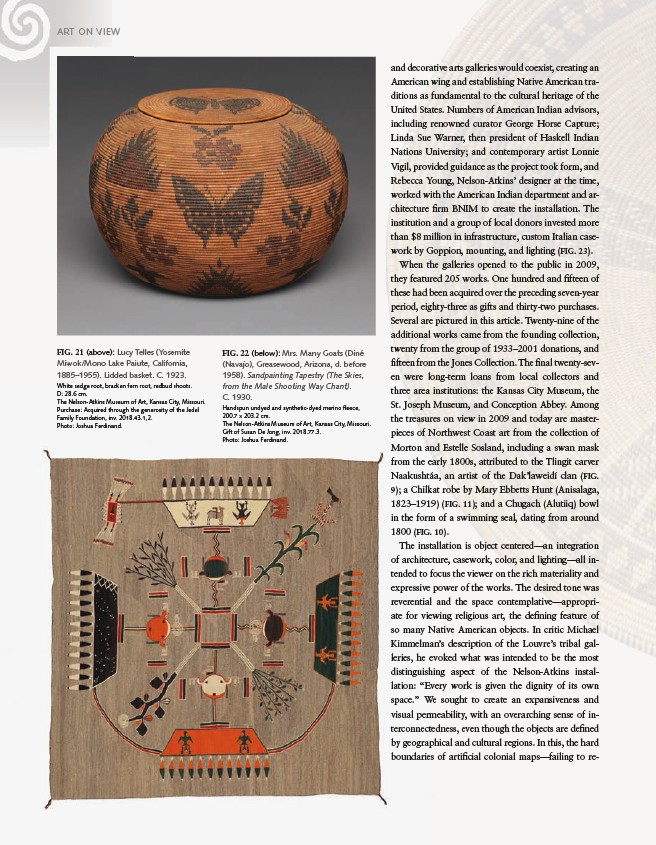
FIG. 21 (above): Lucy Telles (Yosemite
Miwok/Mono Lake Paiute, California,
1885–1955). Lidded basket. C. 1923.
White sedge root, bracken fern root, redbud shoots.
D: 28.6 cm.
The Nelson-Atkins Museum of Art, Kansas City, Missouri.
Purchase: Acquired through the generosity of the Jedel
Family Foundation, inv. 2018.43.1,2.
Photo: Joshua Ferdinand.
116
FIG. 22 (below): Mrs. Many Goats (Diné
(Navajo), Greasewood, Arizona, d. before
1958). Sandpainting Tapestry (The Skies,
from the MaIe Shooting Way Chant).
C. 1930.
Handspun undyed and synthetic-dyed merino fl eece,
200.7 x 203.2 cm.
The Nelson-Atkins Museum of Art, Kansas City, Missouri.
Gift of Susan De Jong, inv. 2018.77.3.
Photo: Joshua Ferdinand.
ART ON VIEW
and decorative arts galleries would coexist, creating an
American wing and establishing Native American traditions
as fundamental to the cultural heritage of the
United States. Numbers of American Indian advisors,
including renowned curator George Horse Capture;
Linda Sue Warner, then president of Haskell Indian
Nations University; and contemporary artist Lonnie
Vigil, provided guidance as the project took form, and
Rebecca Young, Nelson-Atkins’ designer at the time,
worked with the American Indian department and architecture
fi rm BNIM to create the installation. The
institution and a group of local donors invested more
than $8 million in infrastructure, custom Italian casework
by Goppion, mounting, and lighting (FIG. 23).
When the galleries opened to the public in 2009,
they featured 205 works. One hundred and fi fteen of
these had been acquired over the preceding seven-year
period, eighty-three as gifts and thirty-two purchases.
Several are pictured in this article. Twenty-nine of the
additional works came from the founding collection,
twenty from the group of 1933–2001 donations, and
fi fteen from the Jones Collection. The fi nal twenty-seven
were long-term loans from local collectors and
three area institutions: the Kansas City Museum, the
St. Joseph Museum, and Conception Abbey. Among
the treasures on view in 2009 and today are masterpieces
of Northwest Coast art from the collection of
Morton and Estelle Sosland, including a swan mask
from the early 1800s, attributed to the Tlingit carver
Naakushtáa, an artist of the Dak’laweidí clan (FIG.
9); a Chilkat robe by Mary Ebbetts Hunt (Anisalaga,
1823–1919) (FIG. 11); and a Chugach (Alutiiq) bowl
in the form of a swimming seal, dating from around
1800 (FIG. 10).
The installation is object centered—an integration
of architecture, casework, color, and lighting—all intended
to focus the viewer on the rich materiality and
expressive power of the works. The desired tone was
reverential and the space contemplative—appropriate
for viewing religious art, the defi ning feature of
so many Native American objects. In critic Michael
Kimmelman’s description of the Louvre’s tribal galleries,
he evoked what was intended to be the most
distinguishing aspect of the Nelson-Atkins installation:
“Every work is given the dignity of its own
space.” We sought to create an expansiveness and
visual permeability, with an overarching sense of interconnectedness,
even though the objects are defi ned
by geographical and cultural regions. In this, the hard
boundaries of artifi cial colonial maps—failing to re-